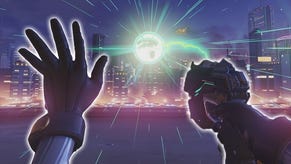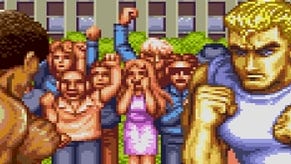Guitar Hero III
Rock Band who?
Words cannot describe the joy that beset me upon discovering that Guitar Hero 3 has a Die Toten Hosen track in it. No, seriously. I have long harboured an ardent and obscure love for German-language music, a passion that has seen me go to great lengths in the past to obtain Singstar Deutsch Rock-Pop, and which often furrows the brows of nosy friends as they browse through the contents of my iPod. It also made me very nearly lose control when Die Toten Hosen themselves actually appeared on stage at Sony's press conference back in Leipzig, and I think I may have rather alarmed Tom. Anyway, whilst everyone else was either grumbling or shrugging at the news that Guitar Hero 3 will have a slightly international track list in Europe, I was jumping up and down with glee. Hier Kommt Alex AND In Flames' Take This Life? It's like they're making this game just for me.
Guitar Hero 3 is out really rather soon now - probably the start of November, although it still has no exact release date - and it's all very exciting. The games media might have been a little swept up in the excitement of Rock Band since its unveiling in July, but in the meantime, Neversoft has been refining and subtly altering the Guitar Hero franchise, ensuring that this is not a series to be forgotten about. Guitar Hero 3 is polished, professional and very, very focused; it takes the gaming purity of Guitar Hero 2 and sticks it into a much slicker environment. It feels like much more of a brand now, and that is undoubtedly a fantastic thing. Everything about it has a pleasing aura of professionalism, from the vast number of original tracks to the appearance of real-life rock gods as playable characters - even the new Les Paul guitar is just miles ahead of the previous two, despite being based on the exact same technology. That's the thing with Guitar Hero 3 - it's exactly the same actual game as Guitar Hero 2 (Neversoft has been smart enough not to mess with the mechanics), but it's been bought an Armani suit and some beautiful cologne by its wealthy new benefactors, and altogether it looks like it will provide a much more complete rock'n'roll experience.
For one thing, the track selection simply cannot be argued with. It caters for every taste, from Dragonforce's Through the Fire and Flames (oh my goodness) to The Scorpions to Tenacious D. There are just so MANY tracks this time (over 70, of which most are original recordings) that it's difficult to find fault, and there's no way that this selection could inspire the same controversy as Guitar Hero 2's. The downloadable content, too, is going to be much less random and muddled than before. Firstly, it's localised, so international tracks are a certainty - and thankfully, it's not region-locked, so nobody's going to have to go through nationality-changing acrobatics on Xbox Live to get their hands on the latest black-metal downloads for the Norwegian audience. Coupled with the increased multiplayer options, the track selection suggests an inclusive atmosphere for Guitar Hero 3 - it's just as much for drunk friends and embarrassing dads as it is for fans, which arguably wasn't true of its predecessor.

The guitar itself, though, is pure fan service - sorry, fellow Guitar Hero fans, but we're probably all going to want to spend yet another fifty quid on it, whichever system we buy it for. You'll forgive me if I gloss over the PS2 Kramer-shaped model for now; it's terribly nice, but not as exciting as the new Les Paul shape. It's the same on Wii, PS3 and Xbox 360, which is at least a small relief for completists, and it's very lovely indeed. I'm fully aware of how ridiculous it is to get so excited over a toy guitar, but like the game itself, the new guitar has a much more professional feel. The buttons, thanks to a neat black fill, are considerably less Fischer Price, and they're ever so slightly closer together than on the Xplorer. They're also back to the original curved shape, and the Start and Select buttons have been returned to their rightful positions as fake tone dials, instead of tiny, barely visible wee buttons set too far away from the strum bar to be of any use. The neck is detachable for easy transport, but it's properly made, with lock buttons and everything - it won't fall off in the middle of an enthusiastic solo. The faceplate is also detachable, which is a canny move - personalised guitar faceplates would be an excellent extra revenue stream from the series, and given the popularity of the Guitar Hero series' art style, I can imagine people paying real, actual money for new designs.
All in all, the thing is a joy to play - which is just as well, as there's twice as much content in this game as there was in Guitar Hero 2. As well as plenty more tracks, the Career and multiplayer modes have seen some important changes in structure, and as is customary, Expert mode's difficulty has been ramped up a little. The Career mode is now punctuated by boss battles as well as encores, which should make things a little more interesting. You compete against real-life guitar gods (Slash and Tom Morello are the two names so far), and defeating them unlocks them as playable characters - of which, incidentally, there are considerably more this time around, which should come in useful for multiplayer.

The multiplayer modes are where Guitar Hero 2 most needed improvement, and it's clear that a lot of effort has been expended upon them here. In addition to the online multiplayer, which, we are assured, will be entirely lag-free (I'll believe that when I see it), there is an entirely new multiplayer mode called Guitar Battle. Wonderfully reminiscent of Amplitude's hectic multiplayer, it introduces items into the mix - lefty-flip, speed-up, slow-down and button locking ('broken strings'), to name a few. Hitting note sequences earns you items, and they're deployed against your rival player with a tilt of the guitar. It's good to throw something random into the mix, now and then - Guitar Hero multiplayer has become a rather exhausting battle of skill round these parts, and it's nice to have a more light-hearted option.
The co-operative modes have undergone a refit, too. Not every song in the game has a co-op option - about forty of them do, and it's the best forty, chosen for their suitability as two-player pursuits. Where co-op in GH2 often felt like you were just playing second fiddle much of the time, the balance has been redressed here - there's even a co-op career, which is excellent (although I'm starting to wince at the thought of how many new guitars I'm going to have to buy).
Back when Eurogamer reviewed Guitar Hero 2, we agreed that there was still a wee ways to go. The series has desperately needed online multiplayer, and Guitar Hero 3 delivers it along with an enormous range of other improvements, extensions and fun new additions. But the best thing is that in developing the series into a bigger, slicker brand, Guitar Hero 3 has lost none of the simple, brilliant purity and irrepressible sense of joy that made it a success in the first place. This is a sure-fire hit.




